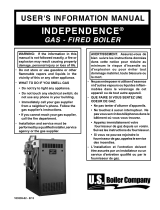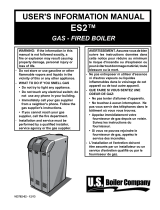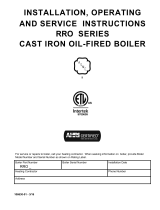
106657-02 - 7/16
WARNING: If the information in this
manual is not followed exactly, a re or
explosion may result causing property
damage, personal injury or loss of life.
- Do not store or use gasoline or other
ammable vapors and liquids in the
vicinity of this or any other appliance.
- WHAT TO DO IF YOU SMELL GAS
• Do not try to light any appliance.
• Do not touch any electrical switch;
do not use any phone in your
building.
• Immediately call your gas supplier
from a neighbor's phone. Follow the
gas supplier's instructions.
• If you cannot reach your gas
supplier, call the re department.
- Installation and service must be
performed by a qualied installer,
service agency or the gas supplier.
User's Information
Manual
RRG™ Series
Gas Boiler

2
The following terms are used throughout this manual to bring attention to the presence of hazards of various risk
levels.
WARNING
Indicates a potentially hazardous situation which,
if not avoided, could result in death, serious injury
or substantial property damage.
CAUTION
Indicates a potentially hazardous situation which,
if not avoided, may result in moderate or minor
injury or property damage.
Important Product Safety Information
Refractory Ceramic Fiber Product
Warning:
The Repair Parts list designates parts that contain refractory ceramic fibers
(RCF). RCF has been classified as a possible human carcinogen. When
exposed to temperatures above 1805°F, such as during direct flame contact,
RCF changes into crystalline silica, a known carcinogen. When disturbed as a
result of servicing or repair, these substances become airborne and, if inhaled,
may be hazardous to your health.
AVOID Breathing Fiber Particulates and Dust
Precautionary Measures:
Do not remove or replace RCF parts or attempt any service or repair work
involving RCF without wearing the following protective gear:
1. A National Institute for Occupational Safety and Health (NIOSH)
approved respirator
2. Long sleeved, loose fitting clothing
3. Gloves
4. Eye Protection
• Take steps to assure adequate ventilation.
• Wash all exposed body areas gently with soap and water after contact.
• Wash work clothes separately from other laundry and rinse washing
machine after use to avoid contaminating other clothes.
• Discard used RCF components by sealing in an airtight plastic bag. RCF
and crystalline silica are not classified as hazardous wastes in the United
States and Canada.
First Aid Procedures:
• If contact with eyes: Flush with water for at least 15 minutes. Seek
immediate medical attention if irritation persists.
• If contact with skin: Wash affected area gently with soap and water.
Seek immediate medical attention if irritation persists.
• If breathing difficulty develops: Leave the area and move to a location
with clean fresh air. Seek immediate medical attention if breathing
difficulties persist.
• Ingestion: Do not induce vomiting. Drink plenty of water. Seek
immediate medical attention.

3
Basic Operation
CAUTION
Should overheating occur or the gas supply fail to shut off, do not turn off or disconnect the electrical
supply to the circulator. Instead, shut off the gas supply at a location external to the appliance.
Do not use this boiler if any part has been under water. Immediately call a qualied service technician
to inspect the boiler and to replace any part of the control system and any gas control which has been
under water.
A. General. This water boiler is equipped with controls
for proper operation. All controls must be in proper
working order. Contact a qualied service agency to
provide annual maintenance as specied in Installation,
Operating and Service Instructions.
1. Limit. See Figure 1. A device which automatically
interrupts boiler operation when the water
temperature exceeds the set point. Maximum
allowable temperature is 220°F.
Original equipment with this boiler is an Integrated
Boiler Control (IBC) and Limit Rated Sensor
combination. The IBC shuts off boiler main
burners when boiler water temperature exceeds
pre-programmed IBC water temperature set point.
Boiler main burners will re-light automatically,
providing the call for heat is present, when boiler
water temperature falls below pre-programmed
control water temperature set point less the set point
differential.
2. Flame Rollout Switch. See Figure 1. A device
which automatically interrupts boiler operation
when ames or excessive heat are present in the
combustion area enclosure. The control is a single
use device. The control is located in the combustion
area enclosure. If the control was activated to
interrupt boiler operation, do not attempt to place
boiler in operation. Contact a qualied service
agency.
WARNING
Service on this boiler should be undertaken only
by trained and skilled personnel from a qualied
service agency.
WARNING
Do not reset Blocked Vent Switch unless a
qualied service agency has determined and
corrected the cause of any blockage in the vent
system or chimney.
3. Blocked Vent Switch See Figure 1. A device
which automatically interrupts boiler operation
when excessive vent system blockage occurs. If the
control was activated to interrupt boiler operation,
do not attempt to place boiler in operation. Contact
a qualied service agency.
4. Electronic Ignition System - see Figure 1. The
Electronic Ignition (EI) System consists of:
a. a solid state ignition control with integral
ignition module to initiate, monitor and stop
burner operation. The IBC performs this
function.
b. a combination gas valve to regulate gas ow to
the main burners.
c. a pilot burner to provide the ignition source for
the main burners.
B. Instructions to place the boiler in operation and to turn
off the boiler are shown on the Operating Instruction
Label posted on the inside of the front door. The
Operating Instruction Label is shown in Figure 2.
C. The Sequence of Operation is shown in Figure 3.

4
Figure 1: Control Locations

5
Figure 2: Operating Instructions

6
Figure 3: Sequence of Operation
Thermostat Calls
for Heat
Circulator Output
Energizes
Waiting For
Damper to Open
Ignition Source Energized
Pilot Gas On
Limits Closed Checked
Trial For Ignition
Ignition Source Off
Main Gas On
Pilot Flame Proven
Pilot Flame
Not Proven
Call For Heat Ends
Standby
POWER
(Control LED’s
Illuminated)
DAMPER
Delay 5 Minutes
Ignition Source Off
Pilot Gas Off
Main Gas Off
Vent Damper De-Energized
Circulator Output De-Energized
Continuous
Retry
POWER
Standby
FLAME
LIMIT
Vent Damper Energized
Self Testing
TSTAT/CIRC

7
User Maintenance
WARNING
Service on this boiler should be undertaken only by trained and skilled personnel from a qualied service
agency. Inspections should be performed at intervals specied in Installation, Operating and Service
Instructions and this manual. Maintain manuals in a legible condition.
Keep boiler area clear and free of combustible materials, gasoline and other ammable vapors and liquids.
Do not place any obstructions in boiler room that will hinder ow of combustion and ventilation air.
A. General Housekeeping (Continuous).
1. Keep boiler area clear and free of combustible
materials and obstructions to the free ow of
combustion and ventilation air to the boiler.
2. Do not store or use gasoline, other ammable
vapors, liquids or sources of hydrocarbons in the
vicinity of the boiler or any other appliance.
3. Do not store or use halogen-containing products
(bleaches, cleaners, fabric softeners, refrigerants,
chemicals, etc.) in the vicinity of the boiler.
B. Inspect Inlet Air and Vent System (Monthly). Check
the following. If corrective action is required contact
qualied service agency.
1. Blocked vent switch must be attached to the canopy.
2. Vent pipe must be full round shape, showing no
damage from impact or excessive temperature.
3. All vent pipe joints must be secure.
4. Horizontal runs must not sag.
5. The vent system must be free of corrosion and other
deterioration.
6. Supports must not be loose or broken.
C. Inspect Pilot and Main Burner Flames (Monthly).
1. Remove jacket front panel.
2. View ames through burner access panel. See
Figure 1.
3. Adjust thermostat to highest setting.
4. Check pilot ame. See Figure 4. The pilot produces
one ame. The ame should be steady, medium
hard blue enveloping
3
/8 to ½ inch of sensing probe.
If ame is yellow and lazy, follow instructions TO
TURN OFF GAS TO APPLIANCE (see Figure 2),
and contact qualied service agency.
5. Check main burner ames. See Figure 5. Flame
should have clearly dened inner cone with no
yellow tipping. Orange-yellow streaks caused
by dust should not be confused with true yellow
tipping. If yellow ames are observed, follow
instructions TO TURN OFF GAS TO APPLIANCE
(see Figure 2), and contact qualied service agency.
6. Adjust thermostat to normal setting.
D. Schedule Inspection by Qualied Service Agency
(Annual or at Beginning of Heating Season). For
continued safe operation a qualied service agency
must provide a more detailed inspection of burners, heat
exchanger and vent system, and provide maintenance
as specied in Installation, Operating and Service
Instructions.

8
Figure 5: Main Burner Flame
Figure 4: Pilot Burner
-
 1
1
-
 2
2
-
 3
3
-
 4
4
-
 5
5
-
 6
6
-
 7
7
-
 8
8
Rand and Reardon RRG164 User manual
- Type
- User manual
Ask a question and I''ll find the answer in the document
Finding information in a document is now easier with AI
Related papers
Other documents
-
US Boiler 203NI-T2 User guide
-
US Boiler 305BNI-T User guide
-
US Boiler SERIES 3 User guide
-
Burnham 1099-01R1-/10 User manual
-
 US Boiler PIN4SNI-ME2 User guide
US Boiler PIN4SNI-ME2 User guide
-
Columbia HERITAGE series Installation, Operating And Service Instructions
-
Burnham 8H/8HE Operating instructions
-
US Boiler 204NI-A2 Installation guide
-
Burnham 8H Series User manual
-
 US Boiler ES28BNI-T User guide
US Boiler ES28BNI-T User guide












